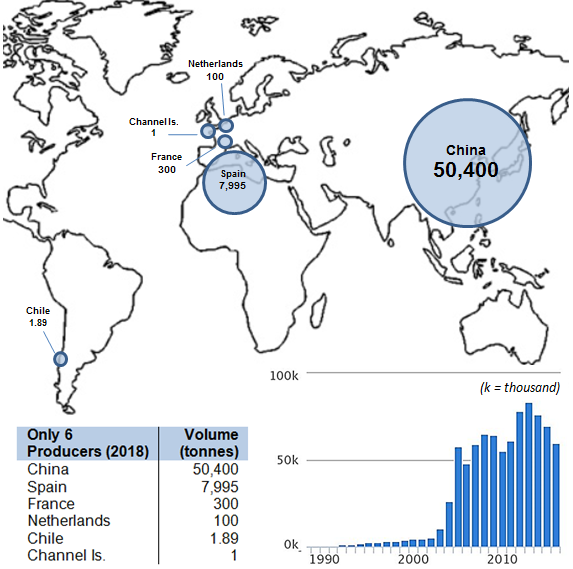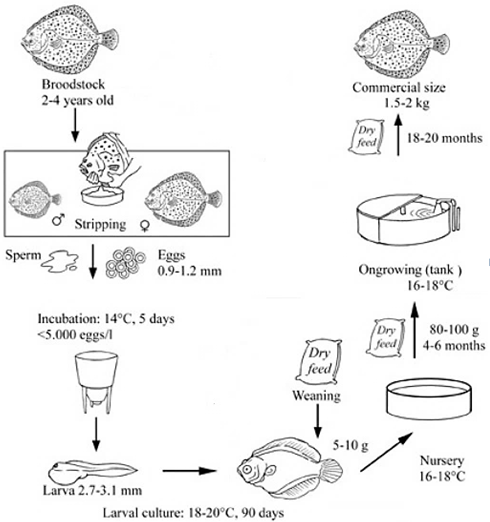Turbot
Psetta maxima
Sources, Quantities and Cultivation Methods
Source and Quantities
Turbot is a medium-sized, carnivorous marine flatfish. It is a fast-growing species living on sandy and muddy bottoms in shallow waters down to 100m. Wild turbot are found from the Northeast Atlantic to the Mediterranean1. Turbot is a commercially important species for both capture fisheries and aquaculture.
Turbot is mainly caught in the southern and eastern parts of the North Sea2. Global capture landings were 6,468 tonnes in 2016. European aquaculture production in the same year was almost double at 10,116 tonnes2. Farmed turbot represented only 0.34% of the total production (by mass) of European aquaculture in 20162.
Turbot aquaculture research started in Scotland and France in the 1970's. In the early 1990s technological developments in juvenile rearing saw the expansion of production into Spain and Portugal, but in 2018 European production was predominantly Spanish1. Since 2003 turbot aquaculture has increased dramatically in China supported by the importation of European juveniles in the 1990's. Turbot are hatched in land-based hatcheries and land-based pump ashore (PAS) (i.e. seawater flow-through systems) are used for on-growing. RAS (recirculating aquaculture systems) is increasingly being used for on-growing turbot3. Open sea culture in bottom net-pens is rarely used today.
Global aquaculture production of turbot has increased rapidly in the last few years and was 58,798 tonnes in 2018, with a total value of US$402 million. This production figure was down some 29% from its peak in 2013 (82,525 tonnes). China and Spain are the two most significant producers2.

European Production
Turbot production in Europe is highly concentrated and integrated with a few major companies with a limited number of large farms mainly in Galicia northern Spain (Portuguese production has hit with problems in recent)3, 4, 5, 6. In 2018 Spain farmed around 8,000 tonnes. Turbot has been farmed in other European countries such as the UK with limited success. countries such as France and Netherlands do farm turbot, but production is still small. Most European farmed turbot is consumed in the producing countries - Spain consumes some 75% of its own production, whilst the remainder is exported across Europe3.
Chinese Production
Turbot is one of the aquaculture species that is cultured using recirculation aquaculture systems (RAS) in the northern coastal areas of China. Chinese RAS for turbot are often small-scale and 'basic’. As these systems continue to develop production can fluctuate7. This may be why Chinese production has decreased 23,500 tonnes from a peak of 73,000 in 2013 to 49,500 in 20162. Turbot farmed in China is primarily to satisfy domestic Chinese demand.
Domestic Market Information8, 9
Over the past ten years, turbot has been in growth in Great British retail (i.e. in England, Scotland and Wales), from a small base, with value and volume up 75% and 436% respectively from a base of £0.18m and 3 tonnes in 2008.
In 2018, UK retail sales of turbot were worth £0.31m (+0.9% compared to the previous year) with a volume of 14 tonnes (-11.7%), average price £22.36 per kg (+14.2%); ranking as the 54th most popular species by value in the 52 weeks up to 16/06/2018 (including discounters.
In 2018, the UK recorded 159 tonnes of imported turbot.
Note: the difference between volume of turbot sold in UK retail and that which is imported is due to its use in the foodservice industry (e.g. restaurants) (no data available) and that which is re-exported.
Production Method1, 3, 10
The production cycle can be divided into two stages: nursery phase (5g to 60-100g), and growth-out to commercial size (1.5-2kg).
Turbot broodstock spawning can be induced all year round by modifying water temperatures and day/night rhythms (photomanipulation), although hormone treatments can also be used. Turbot do not spawn spontaneously in captivity and fish must be hand stripped. Females can produce 5-10 million eggs. After fertilization, embryo development takes 6-7 days.
After hatching, larvae are fed with rotifers, artemia and phytoplankton then weaned with dry pellets for up to 60 days until they reach 5g. During this period the young fish or fry are graded to ensure uniform size and to eliminate those that are smaller, deformed and poorly pigmented.

Turbot can tolerate high stocking densities (up to 100 kg/m², but usually stocked at a maximum of 60 kg/m2 for 1.5 kg fish). Oxygen concentration in waste water leaving the system should never drop below 5 ppm, and preferably be in the range of 6-7 ppm, while rearing temperature needs to be between 16-19°C for the nursery phase and 14-16°C for the grow-out phase. To keep water heating costs to a minimum, turbot farms tend to re-use water after it has been treated to limit fresh seawater intake. Generally, there are relatively low environmental impacts associated with on-shore turbot farming.
Turbot present a challenge to producers in relation to fillet yield, which is much lower than Atlantic salmon, meaning that the production cost per ‘edible’ part of the fish is even higher11.